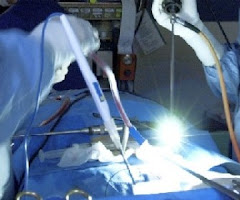Pain is both a physical and emotional experience caused by real or potential injury or damage to the body. It is often best described as a complex three-way warning system. First, acute pain warns of injury. Second, pain warns against further injury by causing the body’s movements to withdraw from the source of injury. Finally, pain leads to a period of reduced activity, enabling injuries to heal more efficiently.
Pain is often difficult to measure because the severity of the pain does not always reflect the severity of the injury. Some people feel extreme pain from relatively small injuries, while others show little or no pain even after suffering a severe injury. Pain can also be present even though no injury is apparent, or pain can linger long after an injury appears to have healed.
Communicate with Your Doctor
Since each person perceives pain a little differently, and responds to pain differently, it is essential that you communicate as much about the exact nature of your pain to medical professionals, including the location, quality and intensity of your pain. Include in your communication the mechanics of the pain:
• How did the pain start?
• How long have you had this pain?
• What kinds of activities make the pain better or worse?
• Is it better or worse when you walk, sit, stand, or lie down?
Therapies with Medicine
The complexity of human pain often requires a combination of pain therapies with medicine and without medicine to achieve relief. In addition to the body’s own mechanisms, humans have devised many different ways to manipulate the body’s ability to control pain. Drugs that relieve pain, known as analgesics, usually interfere with pain impulse transmission in the nervous system. Narcotic analgesics, such as codeine, have chemical structures that are similar to the pain-blocking neurotransmitter endorphin.
Other drugs that relieve pain alter the way damaged nerves transmit information. Non-steroidal anti-inflammatory drugs, such as aspirin and ibuprofen, are analgesics that reduce pain by inhibiting the synthesis of prostaglandins, the body chemicals that intensify pain and cause inflammation.
Medications prescribed by a physician may be used alone or in combination with other medications and can be administered in a variety of ways.
When Surgery is Required
When conservative treatments don't help, back surgery may offer relief. But it doesn't help every type of back pain. In fact, back surgery is needed in only a small percentage of cases and is usually reserved for times when a nerve is pinched, the spinal cord is compressed or there is too much movement between the spinal bones.
Traditionally, back surgery was one of the most grueling and damaging surgical procedures a patient could endure. Now, through the utilization of cutting edge technology, patients can undergo many back and spine operations in a whole new way. These updated versions of traditional back surgeries allow for great precision, faster healing, and less damage to healthy tissue.
Open back surgery uses large open incisions and multiple levels of tissue and muscle dissection to view the spine. Modern procedures that are less invasive use a combination of surgical and technological innovations in order to repair spinal conditions without having to disturb surrounding healthy tissue.
Consider all options
Before considering any back surgery, obtain a second opinion from a qualified spine specialist. Back and leg pain can be a complex issue that may possibly require a team of health professionals to diagnose and treat. It is important to choose your spine team wisely.
To prevent recurrent back problems, learn and practice good body mechanics, maintain proper body weight, and keep your back muscles conditioned with regular exercise and stretching.
Tuesday, July 8, 2008
Subscribe to:
Post Comments (Atom)


1 comment:
Thank you for sharing such an in-depth article!
laser spinal surgery Houston, TX
Post a Comment